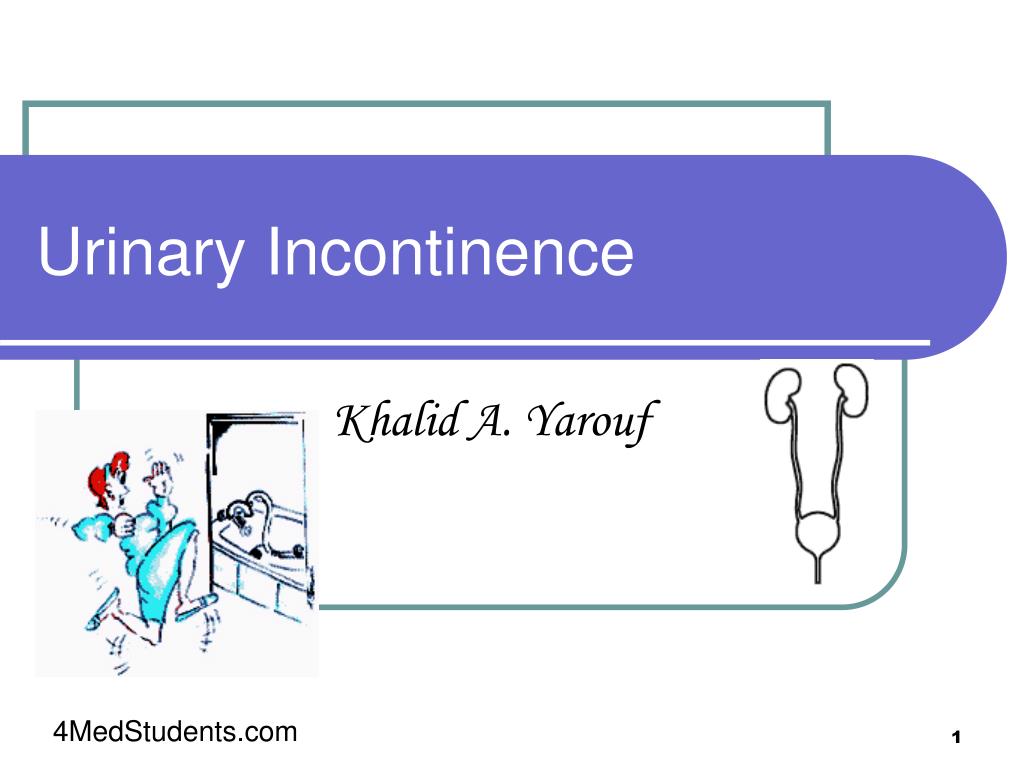
URINARY INCONTINENCE AND URINARY RETENTION. Urinary incontinence (UI) - ppt download
5 (690) In stock

5 (690) In stock
DEFINITION Urinary incontinence (UI): is any involuntary leakage of urine. Urinary incontinence in elderly patients often decreases their ability to maintain an independent lifestyle. Urinary incontinence affects people of all ages but is particularly common among the elderly. urinary incontinence is not a normal consequence of aging, age- related changes in the urinary tract predispose the older person to incontinence.
URINARY INCONTINENCE AND URINARY RETENTION
Urinary incontinence in elderly patients often decreases their ability to maintain an independent lifestyle. Urinary incontinence affects people of all ages but is particularly common among the elderly. urinary incontinence is not a normal consequence of aging, age- related changes in the urinary tract predispose the older person to incontinence..
Genitourinary surgery. Pelvic muscle weakness. Incompetent urethra due to trauma or sphincter relaxation. Immobility. High-impact exercise. Diabetes mellitus. Medications: diuretics, sedatives. Age-related changes in the urinary tract..
It predominately affects women who have had vaginal deliveries and is thought to be the result of decreasing ligament and pelvic floor support of the urethra and decreasing or absent estrogen levels within the urethral walls and bladder base..
The patient is aware of the need to void but is unable to reach a toilet in time. 3- Reflex incontinence : is the involuntary loss of urine due to hyperreflexia in the absence of normal sensations usually associated with voiding. This commonly occurs in patients with spinal cord injury because they have neither neurologically mediated motor control nor sensory awareness of the need to void..
Such over distention results from the bladder’s inability to empty normally. Both neurologic abnormalities (eg, spinal cord lesions) and factors that obstruct the outflow of urine (eg, tumors, strictures, and prostatic hyperplasia) can cause overflow incontinence..
The patient’s voiding history, a diary of fluid intake and output, and bedside tests (ie, residual urine) may be used to help determine the type of urinary incontinence Urinalysis and urine culture are performed to identify hematuria (from infection, cancer, or a kidney stone), glycosuria (causes polyuria), pyuria (urine which contains pus), and bacteriuria (bacteria in the urine), all of which may identify causes of urinary incontinence..
In using these techniques, clinicians help patients avoid potential adverse effects of pharmacologic or surgical interventions 1- Fluid Management:- One of the most common approaches is fluid management because adequate daily fluid intake of approximately 1,500 to 1,600 mL helps to reduce urinary urgency related to concentrated urine production, decreases the risk of urinary tract infection, and maintains bowel functioning..
The individual chooses to void by the clock at the given interval while awake, rather than wait until a voiding urge occurs. 3- Pelvic Muscle Exercise (PME):- Also known as Kegel exercises, aims to strengthen the voluntary muscles that assist in bladder and bowel continence in both men and women. Pelvic muscle exercises are helpful for women with stress, urge, or mixed incontinence and for men who have undergone prostate surgery..
1- Anticholinergic agents (oxybutynin [Ditropan], dicyclomine [Antispas]) inhibit bladder contraction and are considered first-line medications for urge incontinence. 2- Several tricyclic antidepressant medications (imipramine, doxepin, desipramine, and nortriptyline) also decrease bladder contractions as well as increase bladder neck resistance. 3- Estrogen (taken orally, transdermally, or topically) has been shown to be beneficial for all types of urinary incontinence. Estrogen decreases obstruction to urine flow by restoring the mucosal, vascular, and muscular integrity of the urethra..
Avoid bladder irritants, such as caffeine, alcohol Void regularly, 5 to 8 times a day (about every 2 to 3 hours) Perform all pelvic floor muscle exercises as prescribed, every day. Stop smoking (smokers usually cough frequently, which increases incontinence)..
Chronic urine retention often leads to overflow incontinence Residual urine : is urine that remains in the bladder after voiding. In a healthy adult younger than age 60, complete bladder emptying should occur with each voiding. In adults older than age 60 ( 50 to 100 mL) of residual urine may remain after each void because of the decreased contractility of the detrusor muscle..
Some medications cause urinary retention, either by inhibiting bladder contractility or by increasing bladder outlet resistance. Medications that cause retention by inhibiting bladder contractility include anticholinergic agents (atropine sulfate),and tricyclic antidepressant medications Medications that cause urine retention by increasing bladder outlet resistance include alpha-adrenergic agents (ephedrine sulfate, pseudoephedrine), beta- adrenergic blockers (propranolol), and estrogens..
The following questions serve as a guide in assessment: What was the time of the last voiding, and how much urine was excreted. Is the patient voiding small amounts of urine frequently. Does the patient complain of pain or discomfort in the lower abdomen. Is the pelvic area swollen. Does a post void bladder ultrasound test reveal residual urine .
Complications:- chronic infection. pyelonephritis sepsis
Nursing measures to encourage voiding include providing privacy, ensuring an environment and a position conducive to voiding Additional measures include applying warmth to relax the sphincters (ie, sitz baths, warm compresses to the perineum, showers), giving the patient hot tea. After surgery, the prescribed analgesic should be administered because pain in the incisional area can make voiding difficult.
Leaving a light on in the bedroom and bathroom and wearing clothing that is easy to remove when using the toilet.

Managing the Elderly with Urinary Incontinence and Dementia

Lower urinary tract function and disorders: Physiology of Micturition, Voiding Dysfunction, Urinary Incontinence, Urinary Tract Infections, and Painful Bladder Syndrome

PPT - Urinary Incontinence PowerPoint Presentation, free download - ID:1229974

Literature flow. UI: urinary incontinence.

Urinary Incontinence (Stress, Urge, Overflow & Functional)

URINARY INCONTINENCE AND URINARY RETENTION. Urinary incontinence (UI) - ppt download

URINARY INCONTINENCE AND URINARY RETENTION. Urinary incontinence (UI) - ppt download

URINARY INCONTINENCE AND URINARY RETENTION. Urinary incontinence (UI) - ppt download

PPT - URINARY INCONTINENCE PowerPoint Presentation, free download - ID:4505635

Urinary retention and incontinence